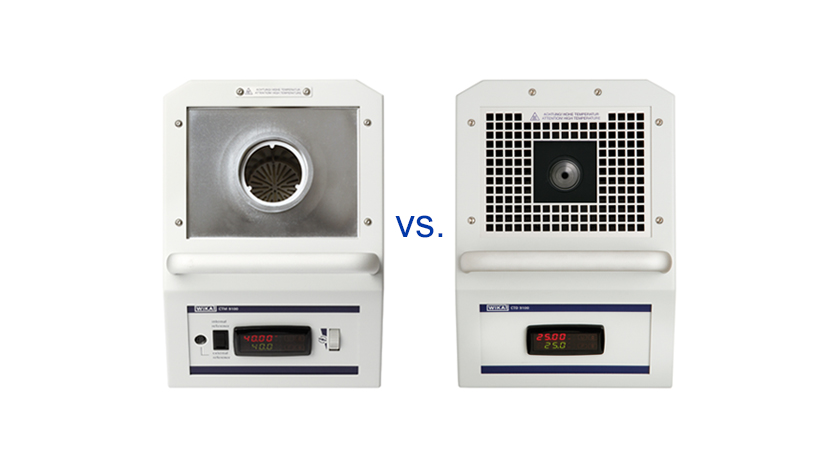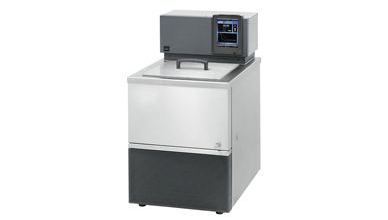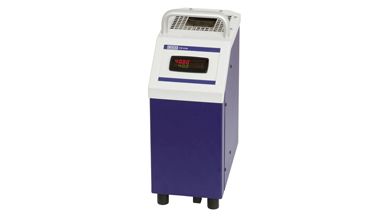
Temperature sensors – like all other sensors – must be calibrated at regular intervals. This ensures that they deliver accurate and consistent measured values. Temperature calibration (e.g. using a calibration bath or dry-well calibrator) is generally carried out by measuring temperature points within the temperature range of the probe. The results are then compared with a reference instrument. Fixed points such as the triple point of water can also be used. This is determined on the international temperature scale from 1990 (ITS-90). By means of the fixed-point method, laboratories can measure and check high-accuracy thermometers such as SPRTs (“standard platinum resistance thermometers”) using a predefined point.
For temperature calibration, various tools can be used depending on the environment, application and industry. Two of the most common tools – with a similar functionality and stability – are the calibration bath and the dry-well calibrator. Both instruments can reach different levels of uncertainty and act as a stable temperature source. The evaluation of their differences and the decision on which of the two to use depends on the application.
Calibration bath – functionality and application possibilites

Example: Calibration bath CTB9400, CTB9500
For a higher degree of temperature uniformity, industry experts recommend calibration baths. Depending on the temperature to be measured for calibration, the bath is either filled with water or with certain types of oil. The probes are immersed for measurement. The water or oil circulates in the calibration bath so that the desired temperature is maintained. Depending on the liquid and the temperature controllers used for heating and cooling, operators often use several baths with different temperature ranges. The sensors can therefore be calibrated at a wide variety of temperatures.
Calibration baths are available either in the form of portable instruments or as large, permanently installed laboratory equipment. They achieve the lowest calibration uncertainties as a result of the stable and uniform temperature environment that they generate. Another advantage is that probes of all sizes and shapes can be calibrated, so long as they can be completely immersed. However, the design of a calibration bath can also be restrictive. Since the test item is immersed in oil or water, calibration baths cannot be used in sterile environments (in which there must be no contamination). A probe which is used in the food industry for temperature measurement of milk, for example, might contaminate the product if it is immersed in oil for calibration.
Dry-well calibrator – functionality and application possibilities

Example: Dry-well calibrator CTD9100
Sterile industries generally rely on dry-well calibrators to calibrate their temperature probes. Their use can be both portable and also stationary in calibration laboratories. Dry-well calibrators are fitted with inserts. These are used to perfectly adapt the probe to the temperature in the block. For calibration, the test item is inserted into the hole provided in the calibration insert. Here, care must be taken that the probe is firmly seated. There should be a maximum of a few millimetres of clearance in order to prevent air flow around the temperature probe which is being checked. The ambient air can influence the measured values and thus falsify the calibration results. If a built-in controller is used, the dry-well calibrator heats or cools to the set temperature in order to check the measurements of the probe and to carry out the necessary calibrations.
Dry-well calibrators are often preferred as a portable calibration method. The user is thus spared having to handle any liquids. They also have the advantage that the probes do not come into contact with other substances that could be harmful to the end product. However, calibrating several probes at once can be a challenge if they have measuring heads which can interfere with each other. In this case, the number of calibrations that can be carried out simultaneously is limited. The user must also purchase several inserts – suitable for the various probes. Most inserts are made of brass or aluminium, although these are not well suited for calibrations at extremely high temperatures. In these applications, ceramic sleeves should be used to ensure a more stable temperature.
Conclusion
Ultimately, the choice between calibration bath and dry-well calibrator depends on the requirements of the respective application. The criteria for consideration are: temperature range, portability, handling of liquid media and temperature stability.
Note
Further information on our calibration baths and dry-well calibrators can be found on the WIKA website. If you have any questions, your contact will gladly help you.

